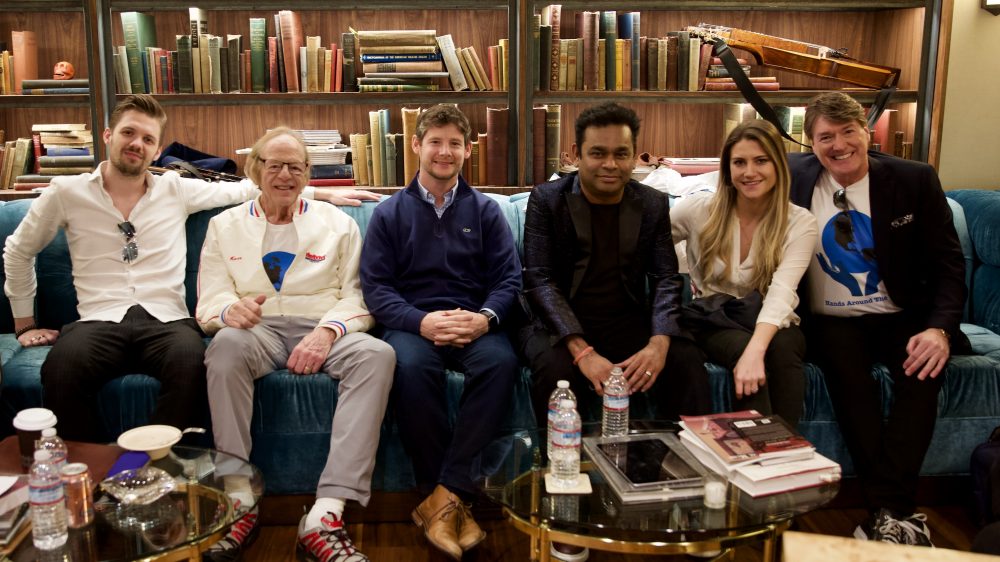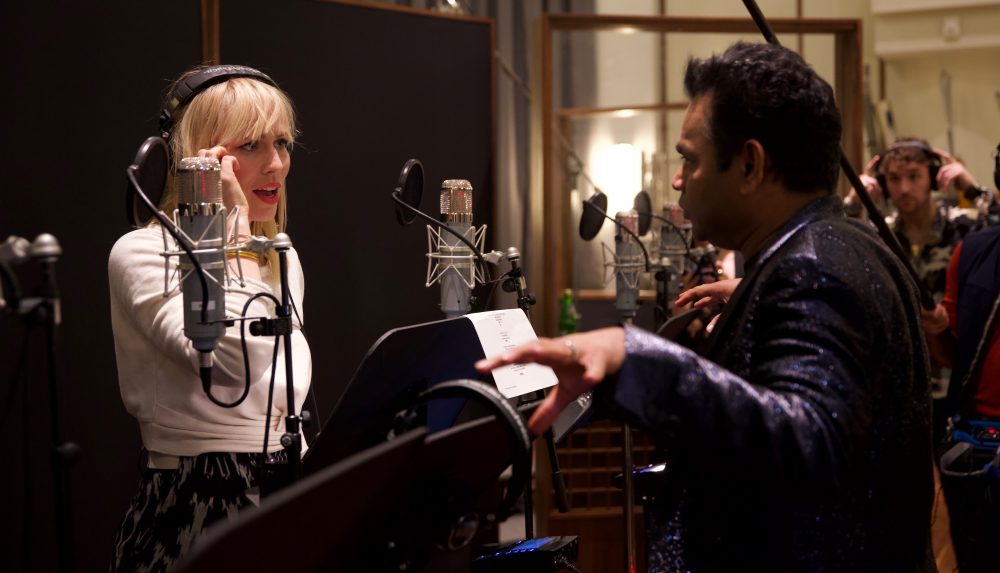A.R. Rahman, Ken Kragen Gathering Stars for ‘We Are the World’-Style Climate Change Single
By Chris Willman
LOS ANGELES (Variety.com) – Three and a half decades after being one of the driving forces behind “We Are the World” and “Hands Across America,” manager Ken Kragen is shifting the focus of his charitable efforts from hunger to the big heat. He’s looking to marshal the same kind of all-star forces and populist appeal that came together in the mid-’80s for a new song, “Hands Around the World,” that’s designed to raise funds and awareness to combat climate change.
The creative driver on this new single-in-progress is , the composer and songwriter whose career ranges from two Oscars for “Slumdog Millionaire” to a recent single and live collaboration with U2 in his native India. Broadway composer Stephen Schwartz wrote some of the lyrics for the new song, which also has a team of international co-writers in Poland’s Julia Zuzanna Sokolowska, K-pop hit songwriter Daniel Caesar and Kevin Doucette, who worked on the theme for the 2020 Tokyo Olympics.
They’re hoping to have the single ready to put out on Earth Day, April 22. If they do make that date, the most ambitious component they’re trying to put together, with entrepreneur Neil Morgan leading the charge, will have to wait further still — it’s an attempt to have fans hold hands around the entire world, not just the America that was attempted in 1986. The hand-holding won’t be literal, though (which may come as a relief, with the coronavirus about). If all goes as planned, fans will buy an app that will plant them at various places on the globe, virtually holding hands with celebrities or fellow civilians. Their modest target for how many will internationally take part in this “selfie chain”? A billion people.
With Rahman in a recording studio in the Valley on a recent weekday afternoon was Natasha Bedingfield, who met the composer when they both performed at the Nobel Peace Prize concert for President Obama in 2019. “We’ve written together before,” Bedingfield said, “and I am a very big environment person, so it’s close to my heart. It was kind of a no-brainer, really, like: I’ll be there.”
That same day, a parade of globally diverse artists was passing through Nathan Barr’s Bandrika studio, from pop singer Cody Simpson to opera star Jonathan Cilia Faro to the Persian singer Sepideh to gospel star Erica Atkins-Campbell of Mary Mary. But Kragen knew that he and Rahman were going to have to go out to the stars, one by one, versus attracting a photo op-ready cluster all in a day.
“I didn’t have to go begging people to join or make a hundred calls,” Kragen remembers of the mid-’80s moment. “Everybody you call, no matter who, even A+ stars, their very first question is, ‘Who do you have?’ I’ve done a lot of these things, and rarely will that one person jump out (first). One of the reasons ‘We Are the World’ worked so well is that I had (in the early 1980s) 48 percent of the top 10 records in 18 months for my clients” — and he had Michael Jackson and Lionel Richie as bait. “So that’s always the first question. Then the second is they want to hear the song obviously. In the case of ‘We Are the World,’ Lionel and Michael didn’t finish it till the day before. In this case we got a demo version we could play for people just last Thursday. But this is a process. Today’s just a start.”
For Rahman, working on the project with Kragen is a way of holding hands with his hero Michael Jackson, across a great divide.
“When I came to America to promote ‘Slumdog Millionaire’ for the Oscars, I told my agent, just to test his capability, ‘Can I meet Michael?’ He said ‘Okay. I know Randy, and I’ll ask him to send a mail.’ And so just after the nominations, he said, ‘Michael wants to meet you.’ And I said, ‘I don’t want to meet him now. If I win, I’ll meet him; otherwise I don’t deserve meeting him.’ I won two, so I go to Michael’s house. … He said, ‘We should do the next “We Are the World.”‘ And I was like, is this surreal? I was sitting with Michael Jackson and he was asking me to write a song. Then that fizzled out because he passed away two months later. It’s unfortunate. And he was in a low at that time, with all the scandal and everything, but I felt like our talk was making him smile.
Everything seemed finished.
“And now, 10 years later, they come to me with this. We can never recreate a song. We can never recreate something which is iconic. You’re not trying to repeat something. But we can do something different.”
“It’s its own thing,” says Morgan, honing in on the ambitious tech side of it, driven byexecutive producers
Ravi Velha
l and
Travis Cloyd (
professor at Florida International University’s iSTAR program)
.
“I think this idea of having a virtual selfie chain around the world is very powerful. And the power of celebrity these days is what will drive the fun factor. It’s a bit like the ice bucket challenge, where it was fun to do and then had a serious message underneath that. They’re getting a celebrity selfie holding one on either side of them. They upload their photo and we link them to another person, to another person. Each person gets a longitude/latitude position on the earth, but randomly, so they could be standing on an ocean or in the Amazon. A little boy from America could be holding a little boy’s hand from Iran, and now those little boys aren’t at war. Will Smith could be holding the hand of a little boy in Africa over a dirty pond, or A.R. Rahman could be holding the hand of a little boy in India. Just that visualization, using these heroes and influencers of the world, is ultimately how I think we’re going to get a billion people to actually join hands.”
As an example, says Kragen, “One of the first people we talked to was Jane Goodall. And we thought, we’ll film a chimp, so you can have Jane Goodall on this hand and a chimpanzee on the other hand, which is a great picture for anybody who’s a fan of Jane.”
Tech advancements will also allow things to proceed a bit differently than they did in the mid-’80s just on the audio side, with stems allowing fans to make their own versions of the song, emphasizing one or several favorite singers. “Everyone has their own choice,” says Rahman. “So we’re recording full verses of the artists like Cody. It doesn’t have to be split up by us. We can have a master version but (fans) can have their own version, where their favorite artist can sing the verse and (another) favorite artist can sing the bridge, and they don’t have to all be chopped up. You could have 500 versions of this besides my version.”
Kragen says the idea is to stay apolitical but affect change at the governmental level. As unlikely as that might seem with a climate change denier in the White House, he says “Hands Across America” had completely unforeseen political results when Reagan was president.
“‘We Are the World’ was done to save lives in Africa and really did save millions,” Kragen says. “But when I got back from Africa after the first trip with all the supplies, at the L.A. airport, the guy who picked me up, just a volunteer, turned to me and said, ‘Mr. Kragen, it’s nice what you’re doing for Africa, but we’ve got hungry and homeless people in poverty here. What are you going to do about that?’ And the idea had been suggested to me of Hands Across America, but as a promotion for ‘We Are the World’ by one of the publicists who was working on that. This flashed in my head as what we ought to do. And I realized that the administration at that time was denying the issues of hunger and homelessness in America. In ‘86, Reagan stood in the line, and it was great that he did, because it made it bipartisan. But the reason he did it was that a week before, he had said there isn’t any problem with hunger and homelessness in America and there shouldn’t be.
“That got Reagan in a lot of heat, and so suddenly we were allowed to go right through the portico of the White House, and he became a participant. Then right afterward, the Congress put $1.3 billion into poverty legislation, which he signed. We’re trying to make this totally unpolitical, but we have an administration now that doesn’t believe in climate change at this point. Most of the people in the world know it’s a problem. But unless they’re faced with it immediately, like you’re in the fires in Australia, or you’re in flooding in a small island where the sea is rising, they don’t get the immediacy of it. We’re in the middle of it now. This isn’t something that’s going to happen in 2030 or 2050. It’s going to be a lot worse by then, but it’s happening now. And this gives us the opportunity to reach out and educate, and then to call to action. And I think these things can change the world, literally, and save the planet. So I feel like this is the project of my life.”
Admits Rahman: “I think that there’s a sense of boredom when you talk about this issue —it’s like a broken record, global warming. But I think through music and through the activity of something you do creatively with augmented reality, it’s going to seem really, really exciting and create a whole new level of interest and engagement.”


